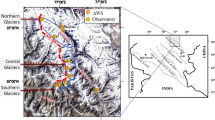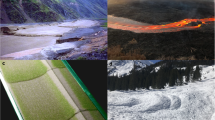Abstract
Preventive avalanching in the Khibiny has been carried out for almost 90 years. The experience accumulated in this area allows evaluating it critically. The methods of preventive avalanching in the Khibiny Mountains, in other regions of Russia, and other countries are analyzed. The most widely used methods are those based on the effects of explosions on the snowpack stability. Despite such long-term experience, a scientific basis for their use is not sufficiently developed, and there are no rational methods for their application. The insufficient knowledge of the mechanisms of avalanche release and short-term impulse loads on the snow stability, as well as the high spatial variability of snow characteristics that control its stability at an avalanche starting zone, and the almost complete absence of their measurements are the main obstacles to solving these problems. The development and realization of a state program aimed at improving the effectiveness of artificial avalanche release could make the current situation better.


Similar content being viewed by others
REFERENCES
V. N. Akkuratov and V. D. Panteleev, "Effects of Bomb Explosions on Changes in the Structure, Density, and Stability of Snow on Mountain Slopes," in The Physics of Snow, Avalanches, and Glaciers (Leningrad, 1967) [in Russian].
N. V. Barashev, E. A. Podol’skii, P. A. Chernous, O. Abe, and K. Nishimura, "Shear Strength Tests of Snow and Methods to Interpret Them for Assessing Snow Stability on a Slope," Materialy Glyatsiologicheskikh Issledovanii, No. 107 (2009) [in Russian].
V. R. Bolov, Temporary Guidelines on Preventive Avalanche Triggering Using KS-19 Artillery Systems, Ed. by M. Ch. Zalikhanov (Gidrometeoizdat, Moscow, 1984) [in Russian].
A. R. Gerber and V. S. Matvienko, "Effects of Impulse Loads on the Stability of Snow Cover Flowing Down the Slope," in Problems of Designing the Baikal–Amur Mainline (Novosibirsk, 1978) [in Russian].
Yu. L. Zyuzin, Severe Face of the Khibiny Mountains (Poligrafiya, Murmansk, 2006) [in Russian].
V. S. Matvienko and A. R. Gerber, "Experimental Studies of Explosions in the Snow," in Design, Construction, and Maintenance of Railroads in Complex Physiographic Conditions (Novosibirsk, 1972) [in Russian].
E. G. Mokrov and N. V. Barashev, "Changes in the Parameters of Avalanche Occurrence in the Near Zone from the Place of Explosion," Led i Sneg, No. 2 (2013) [in Russian].
M. M. Atwater, The Avalanche Hunters (Mir, Moscow, 1980) [Transl. from English].
RD 52.37.790-2013. Organization and Implementation of Avalanche Protection Activities (Roshydromet, Nalchik, 2013) [in Russian].
RD 52.37.849-2016. Guidelines on Using the Nuris Portable Avalanche System for Preventive Avalanche Triggering (Roshydromet, Nalchik, 2016) [in Russian].
M. A. Sadovskii, "Mechanic Air Blast Effects According to Experimental Studies," in The Physics of Explosion, Issue 1 (AN SSSR, Moscow, 1952) [in Russian].
W. Flaig, Lawinen. Abenteuer und Erfahrung Erlebnis und Lehre (Izd-vo Inostrannoi Literatury, Moscow, 1959) [Transl. from German].
P. A. Chernous, "On Rationalizing Measurements of Snow Characteristics to Assess Snowpack Stability on a Slope," Gidrosfera. Opasnye Processy i Yavleniya, No. 1 (2019) [in Russian].
P. A. Chernous, N. V. Barashev, and Yu. V. Fedorenko, "Variability of Snow Characteristics and Avalanche Occurrence," Led i Sneg, No. 1 (2010) [in Russian].
D. Abromeit, "United States Military Artillery for Avalanche Control Program: A Short History in Time," in Proceedings of the 2004 International Snow Science Workshop (Jackson Hole, Wyoming, 2004).
Avalanche Test Sites and Research Equipment in Europe— An Updated Overview, Ed. by M. Barbolini and D. Issler, Report number: SATSIE Deliverable D8 (2006).
G. Borrel, "Recent Improvements in Catex (Avalanche Control Ropeway) Technology," in Proceedings of the 1988 International Snow Science Workshop (Whistler, BC, Canada, 1988).
J. Brenan, "Evolution of the Avalauncher," in Proceedings of the 2006 International Snow Science Workshop (Telluride, Colorado, 2006).
E. Bush, "How Avalanche Forecasters Use Bombs, a Howitzer and an M60 Tank to Keep Us Safe," The Seattle Times, January 23 (2017), https://www.seattletimes.com/seattle-news/eastside/avalanche-man-forecaster-keeps-us-safe-skis-bombs-howitzer-snoqualmie-pass/.
P. Chernous, N. Barashev, Yu. Fedorenko, E. Mokrov, E. Podolsky, and O. Abe, "Explosions and Artificial Avalanche Triggering," in Conference Proceedings. 5th International Conference on Applied Geophysics "Geological Resources–Natural Hazards–Climate Change" (Phuket, Thailand, 2010).
P. Chernous, Y. Fedorenko, E. Mokrov, and N. Barashev, "Studies of Seismic Effects on Snow Stability on Mountain Slopes," Polar Meteorol. Glaciol., 20 (2006).
H. Gubler, "Artificial Release of Avalanches by Explosives," J. Glaciol., 19 (1977).
H. Gubler and S. Wyssen, "Artificial Release of Avalanches Using the Remote Controlled Wyssen Avalanche Tower," in Proceedings of the 2002 International Snow Science Workshop (Penticton, BC, Canada, 2002).
E. A. Podolskiy, K. Nishimura, O. Abe, and P. A. Chernous, "Earthquake-induced Snow Avalanches: I. Historical Case Studies," J. Glaciol., 56 (2010).
E. A. Podolskiy, K. Nishimura, O. Abe, and P. A. Chernous, "Earthquake-induced Snow Avalanches: II. Experimental Study," J. Glaciol., 56 (2010).
P. L. Rosendahl and P. Weibgraeber, "Modeling Snow Slab Avalanches Caused by Weak-layer Failure. Part 1: Slabs on Compliant and Collapsible Weak Layers," The Cryosphere, 14 (2020).
P. L. Rosendahl and P. Weibgraeber, "Modeling Snow Slab Avalanches Caused by Weak-layer Failure. Part II: Coupled Mixed-mode Criterion for Skier-triggered Anticracks," The Cryosphere, 14 (2020).
J. Schweizer and C. Camponovo, "The Skier’s Zone’s of Influence in Triggering Slab Avalanches," Ann. Glaciol., 32 (2001).
J. Schweizer, J. B. Jamieson, and M. Schneebeli, "Snow Avalanche Formation," Rev. Geophys., No. 4, 41 (2003).
S. Simioni, R. Sidler, J. Dual, and J. Schweizer, "Field Measurements of Snowpack Response to Explosive Loading," Cold Reg. Sci. Technol., 120 (2015).
C. Srterbenz, "The Blaster Boxes: Installing, Testing and Operating North America’s First Stationary Avalanche Blasters," in Proceedings of the 2002 International Snow Science Workshop (Penticton, BC, Canada, 2002).
Author information
Authors and Affiliations
Corresponding author
Additional information
Translated from Meteorologiya i Gidrologiya, 2022, No. 8, pp. 14-25. https://doi.org/10.52002/0130-2906-2022-8-14-25.
About this article
Cite this article
Chernous, P.A. Experience of Artificial Avalanche Release: Problems and Prospects. Russ. Meteorol. Hydrol. 47, 582–589 (2022). https://doi.org/10.3103/S1068373922080039
Received:
Revised:
Accepted:
Published:
Issue Date:
DOI: https://doi.org/10.3103/S1068373922080039




